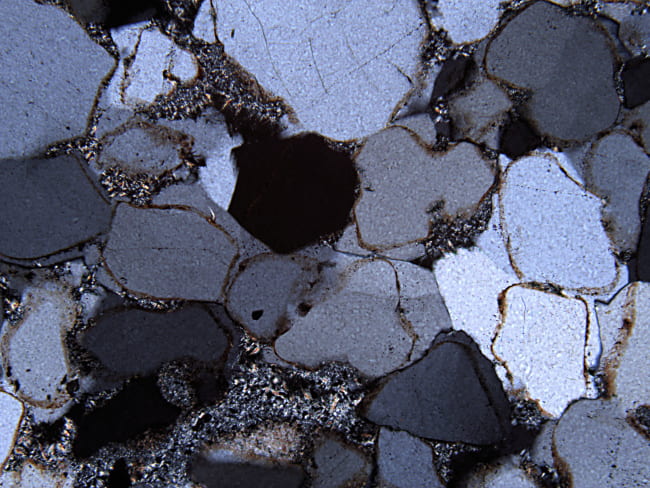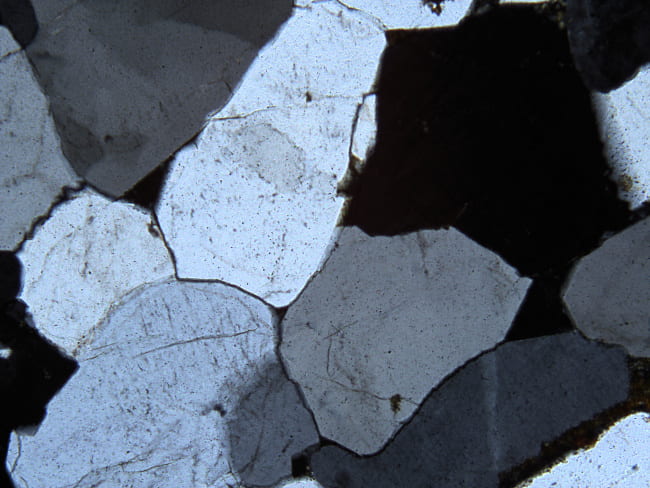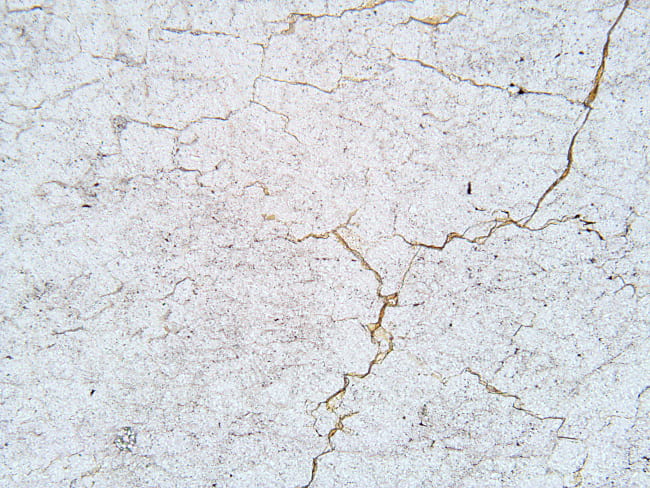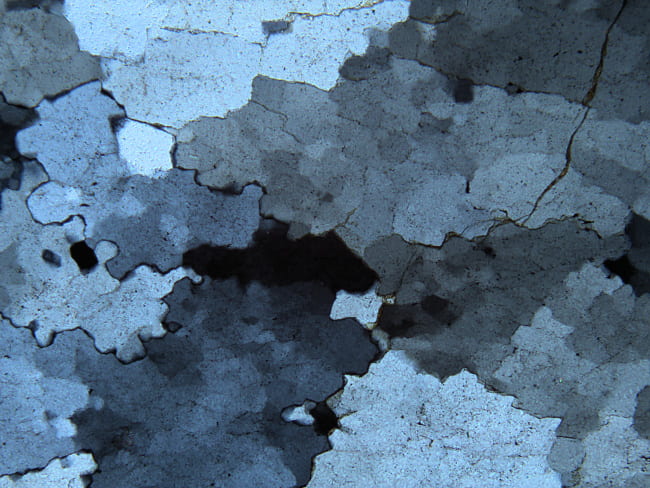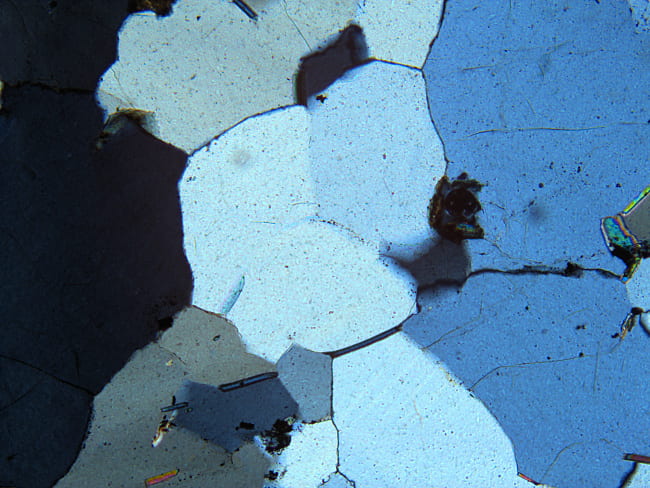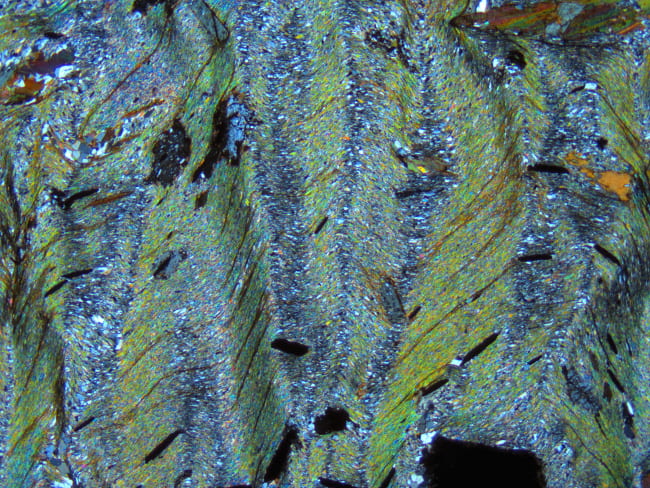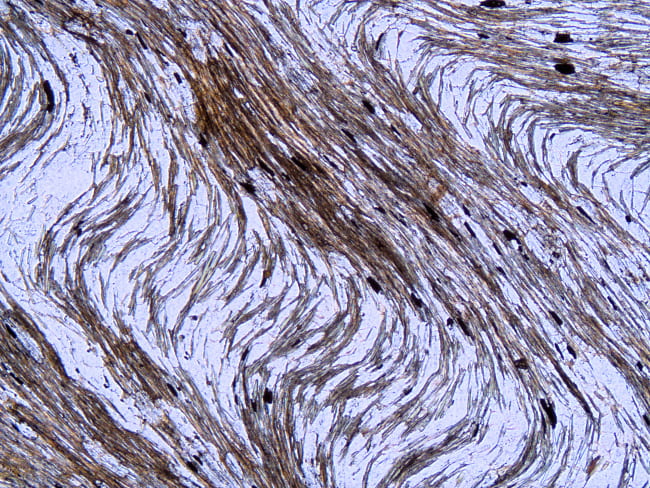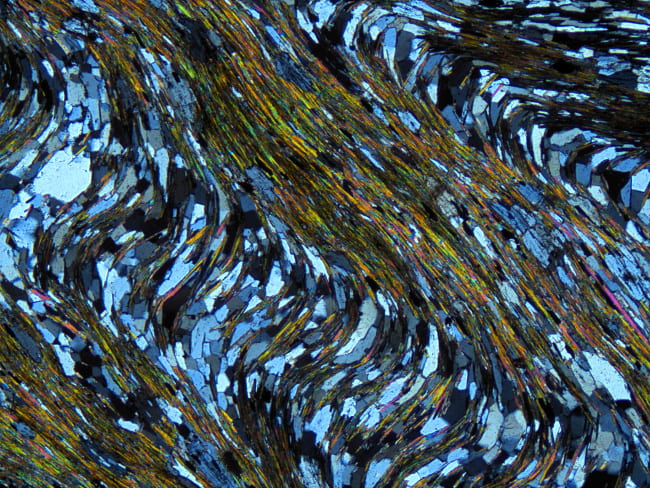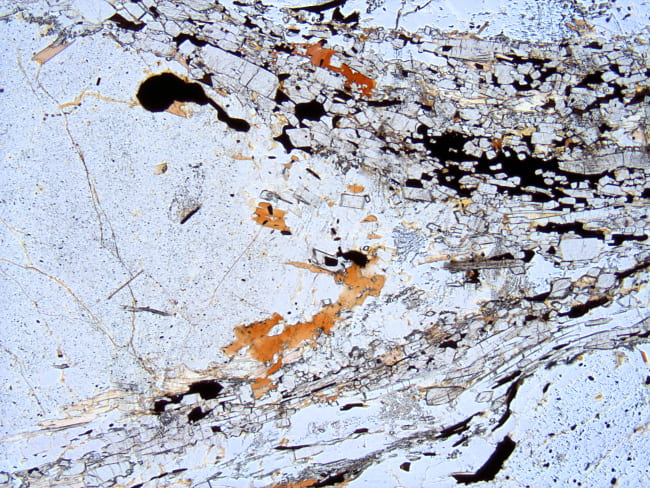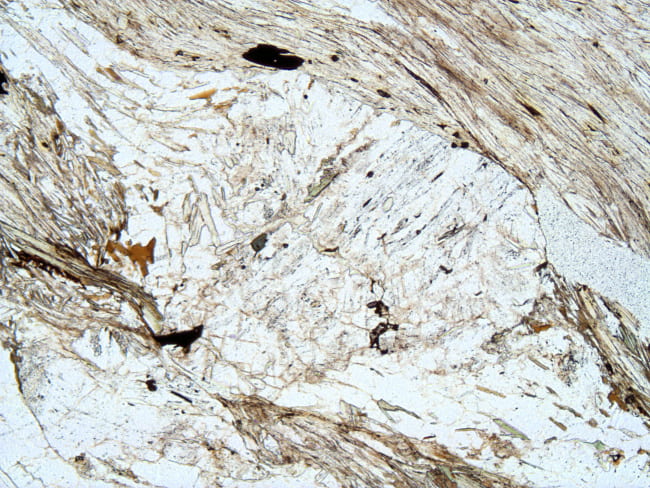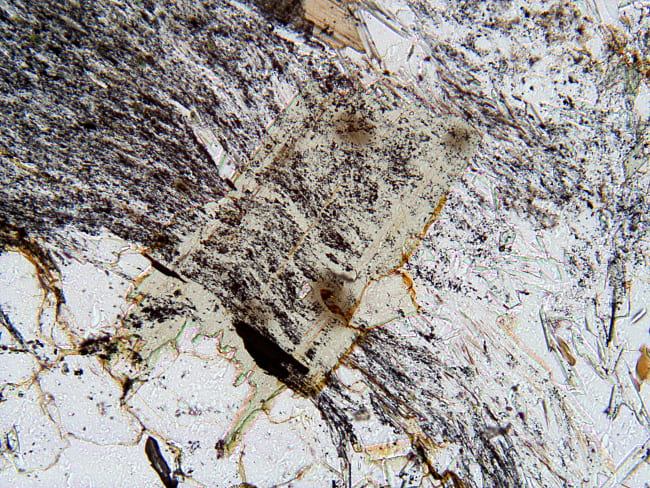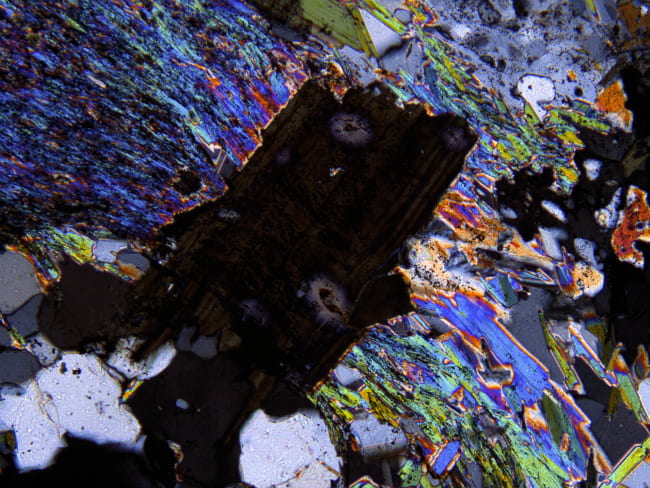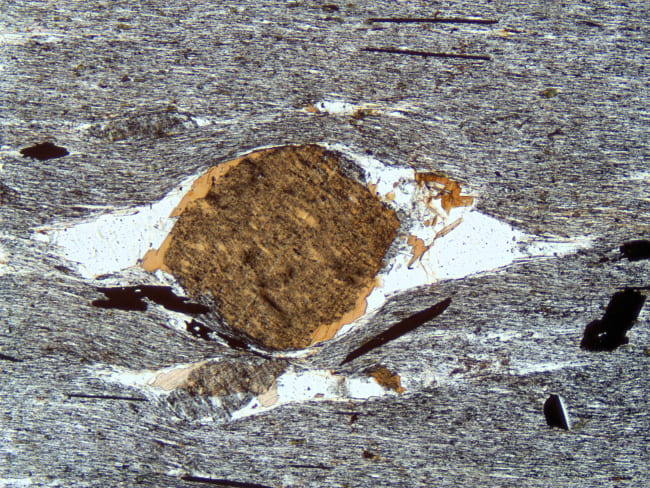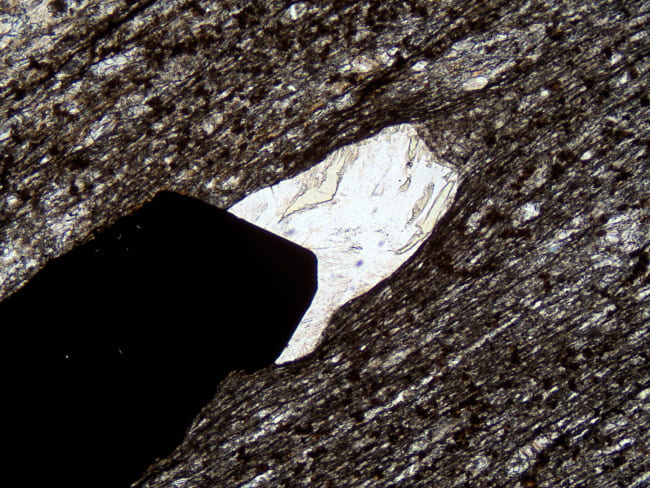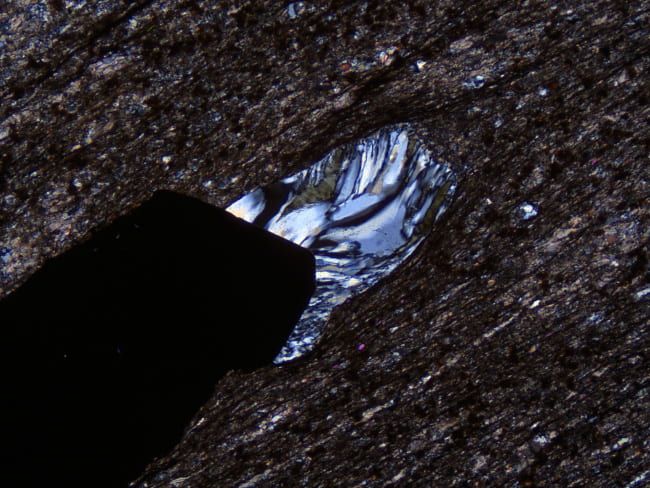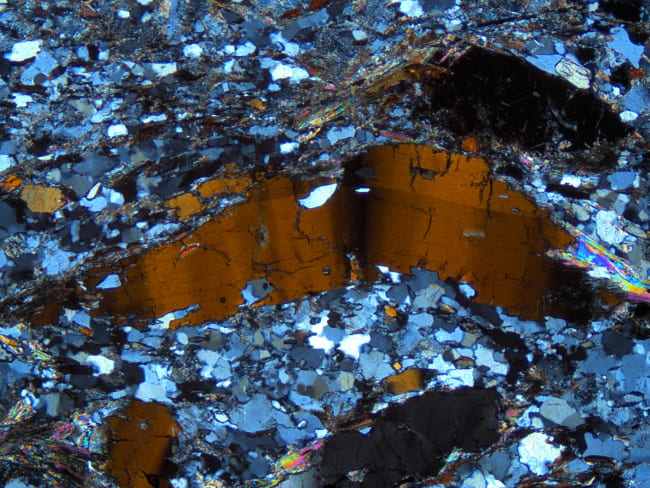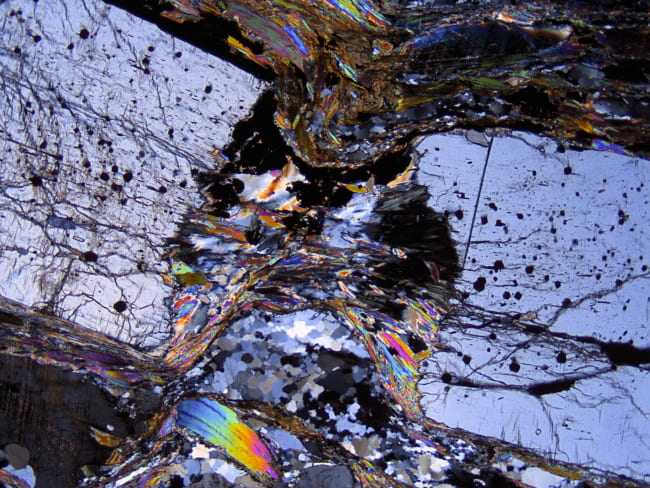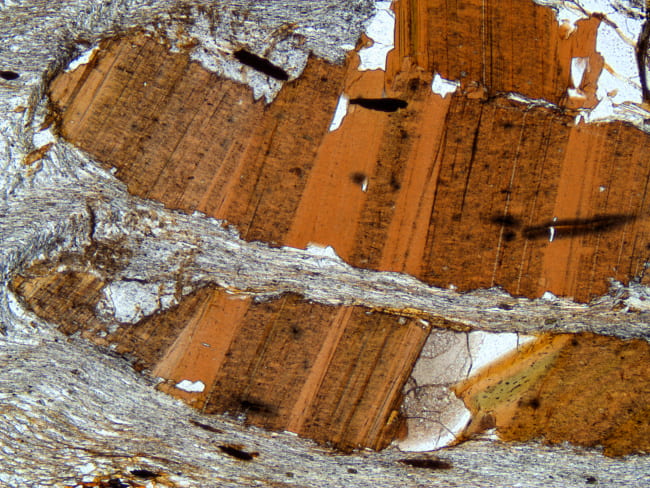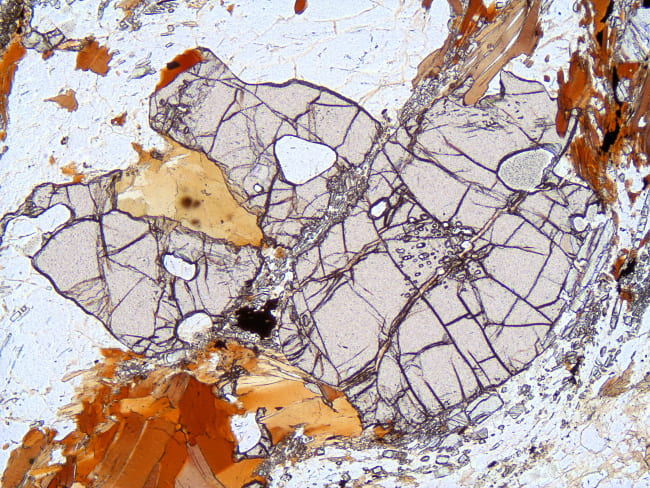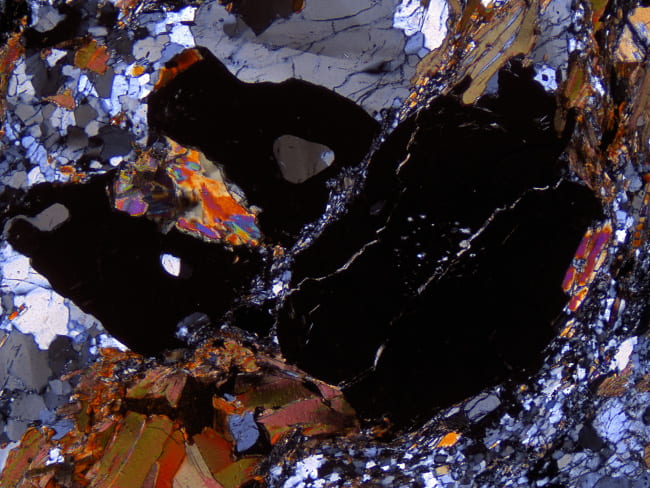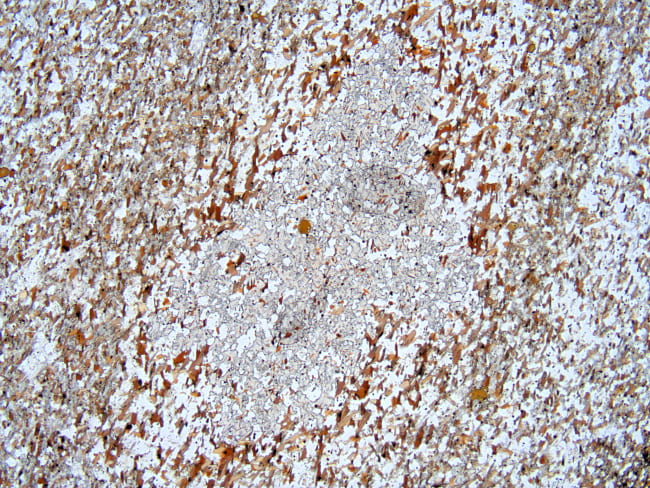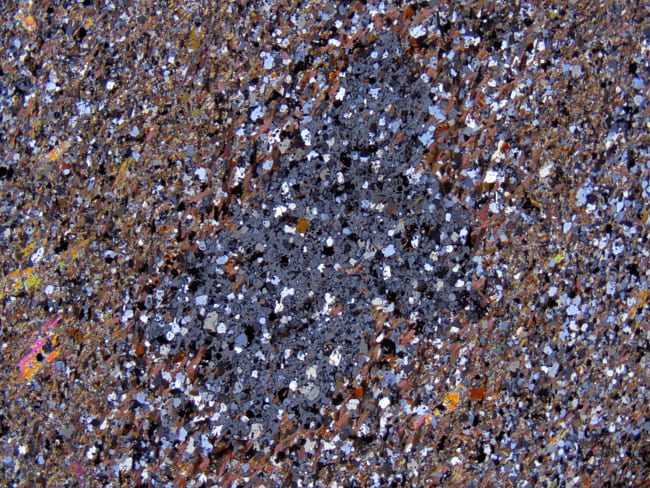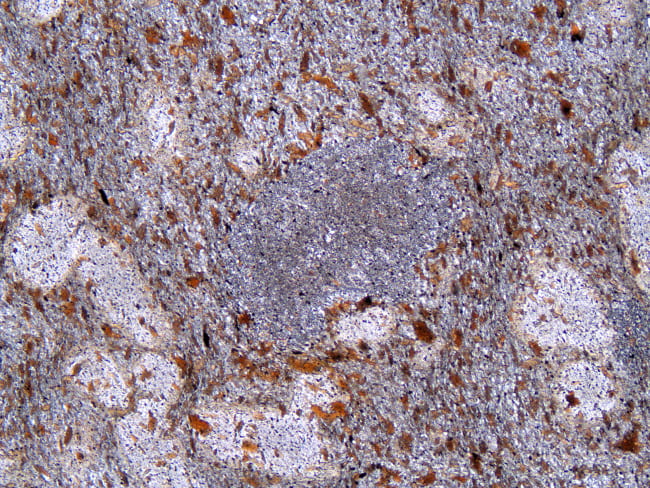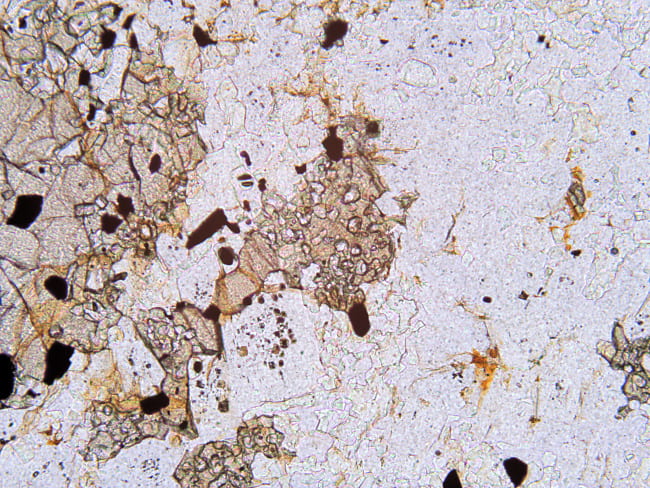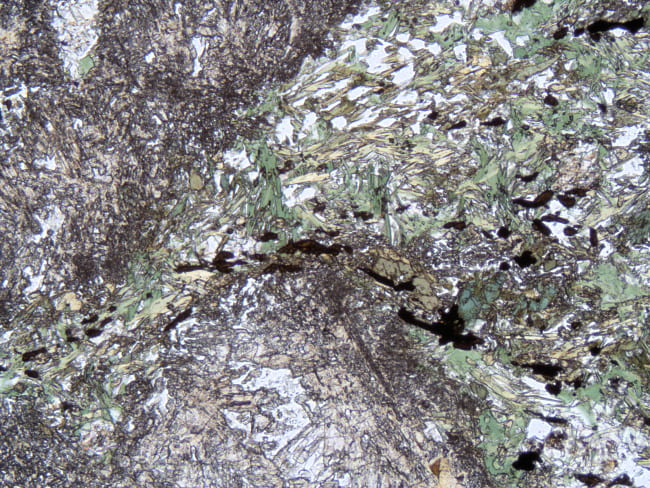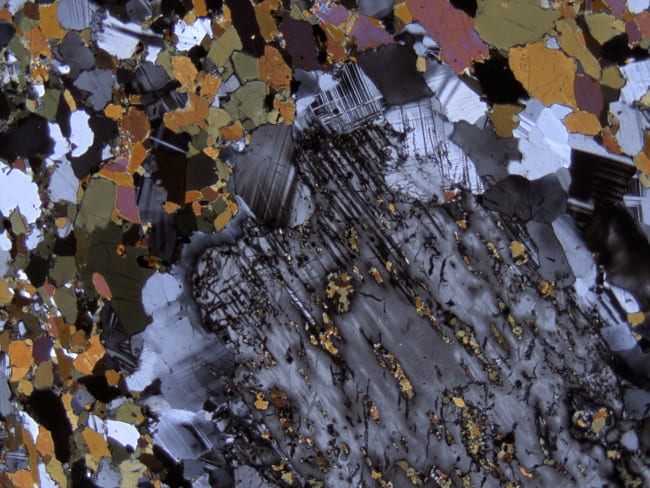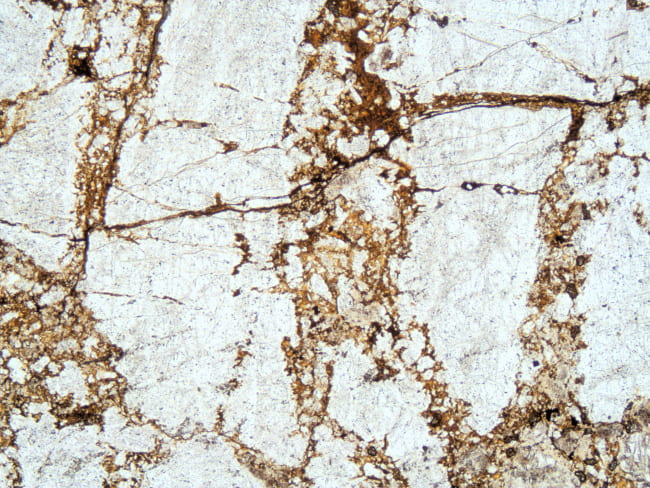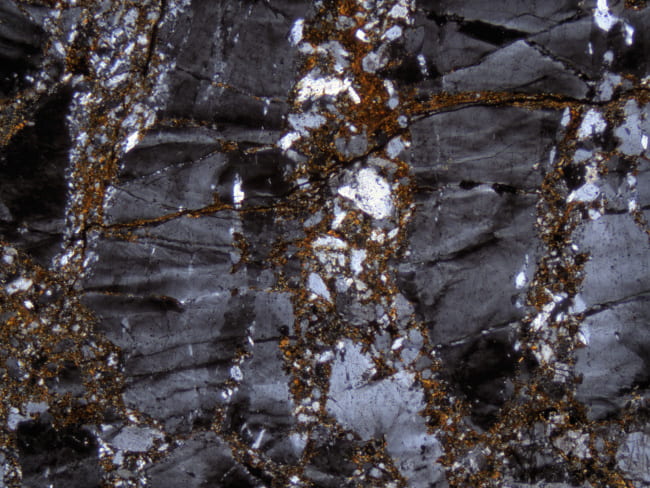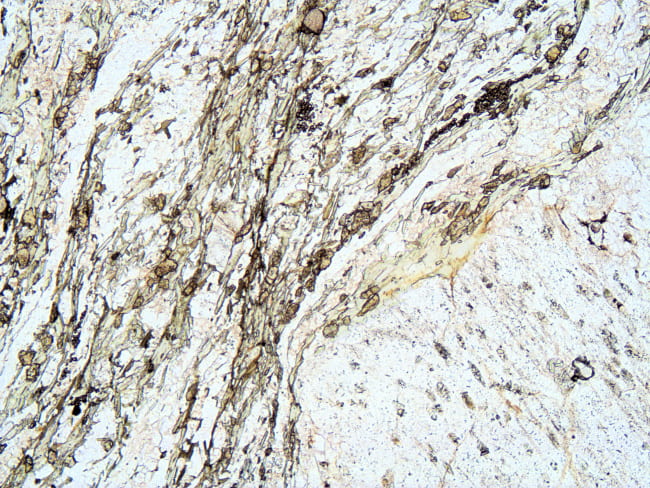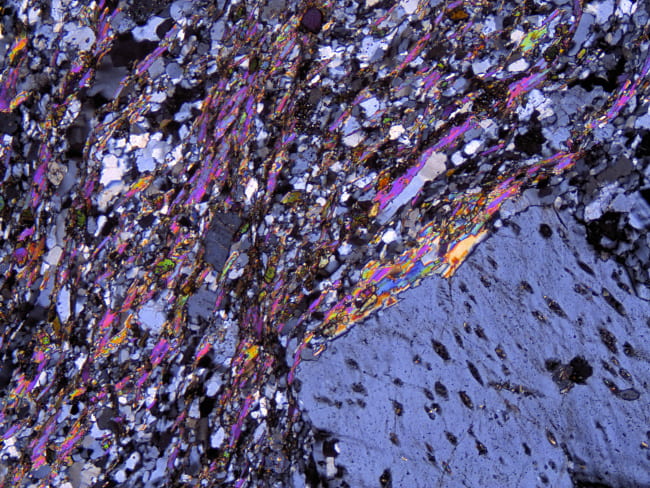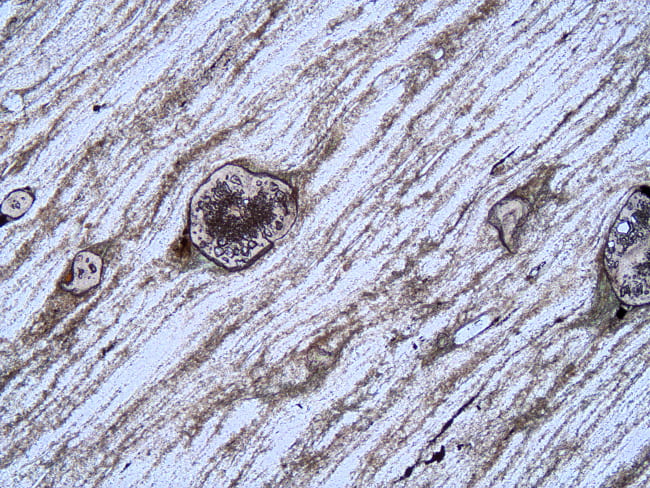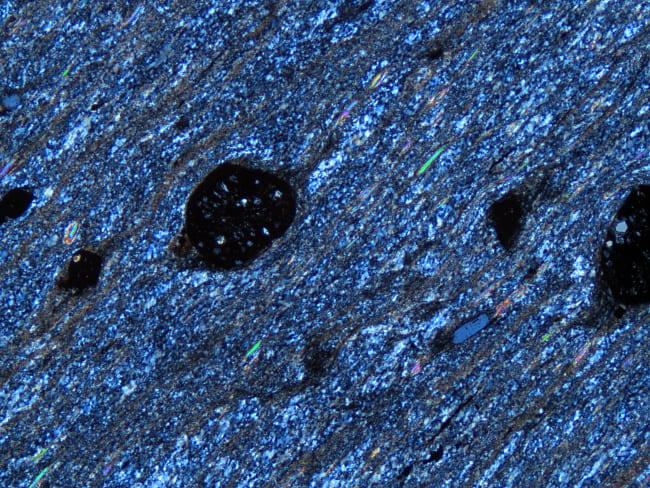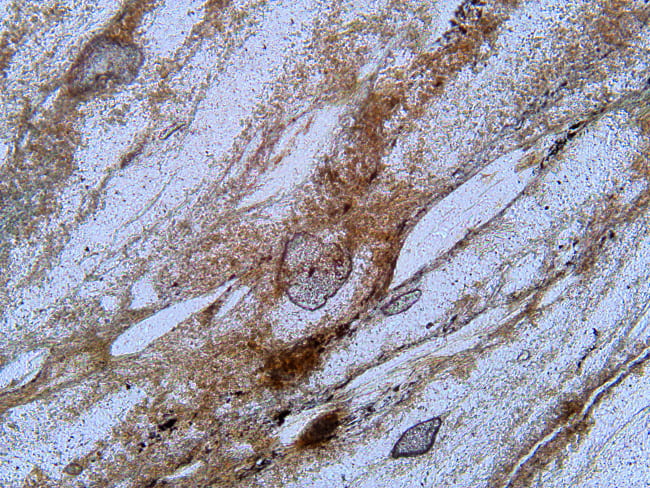Grain size reduction, recrystallization
Crenulations and metamorphic differentiation
Foliation development and overgrowths
Pressure shadows
Bent and broken grains
Contact and burial metamorphism
Relict igneous textures
Fault rocks
This is a somewhat haphazard collection of interesting (to me) metamorphic textures seen in thin section, with some discussion of the processes thought to have made them.
Grain size reduction, recrystallization
Grain sizes in metamorphic rocks are, in part, the result of a competition between deformation, which tends to reduce grain size, and annealing, during which less stable, small and deformed grains grow to form larger, more crystallographically perfect grains. This part shows transformation of sandstone into quartzite, grain size reduction resulting from deformation, and grain growth during annealing.
|
|
Sandstone, with rounded quartz grains cemented together with early hematite, later quartz overgrowths, and lastly illite. This rock is undeformed. Source unknown.
Plane- and cross-polarized light views, field width is 1.2 mm.
W95
|
|
|
Sandstone that has undergone compaction deformation. At grain contacts, where the quartz was under the greatest stress, it dissolved away and either washed away or was reprecipitated nearby as overgrowths. That process is known as pressure solution. Source unknown.
Plane- and cross-polarized light views, field width is 1.2 mm.
W49
|
|
|
This sandstone has undergone minor ductile deformation, with individual sand grains having been strained and partly recrystallized to form a polygonal texture. The original sand grains have largely lost their identity, but can be seen as patches of polygonal domains with similar birefringence. This rock is now a quartzite. Source unknown.
Plane- and cross-polarized light views, field width is 1.2 mm.
W48
|
|
|
Strongly deformed quartzite. The grain size of the original sandstone is indicated by the several large feldspar grains, which have dark cracks or other diagonal lines through them. Feldspar is considerably stronger than quartz under mid-crustal conditions, and resists recrystallization. The quartz grains are largely elongate, defining a foliation, with undulatory extinction. Bennington, Vermont.
Plane- and cross-polarized light views, field width is 1.2 mm.
Bennington_Cheshire
|
|
|
After deformation ceases, small, strained grains recrystallize to grow larger, more crystallographically perfect grains. You can also start to see numerous grain boundaries intersecting at about 120° angles, an indication of an approach to textural equilibrium. Williamstown, Massachusetts.
Plane- and cross-polarized light views, field width is 1.2 mm.
NYSGA95-A7-4
|
|
|
After considerable time, the small, strained grains are replaced by large, strain-free grains, with grain boundaries intersecting at approximately 120°. Recrystallization is driven by the reduction in system energy, caused by lower grain surface area and reduced crystallographic strain. New Salem, Massachusetts.
Plane- and cross-polarized light views, field width is 1.2 mm.
NS-71D
|
Crenulations and metamorphic differentiation
Foliations are among the most prominent features of deformed metamorphic rocks. They form by the progressive re-orientation of platy grains into parallelism. Crenulations are small folds, typically axial planar to larger-scale folds, that deform earlier foliations. Under some conditions, as crenulations develop, some minerals like quartz tend to segregate into the fold hinges, leaving less soluble minerals in the fold limbs. This process can result in a fine-scale compositional layering (sometimes called pinstriping) in a completely different orientation than the original foliation.
|
|
This pelitic schist has a strong foliation defined by muscovite and graphite, oriented approximately SW-NE. That foliation has been deformed by crenulations, small folds in the foliation. Crenulations can be regularly spaced and parallel, or irregularly spaced and generally anastomosing. These are the latter variety. The impression of topographic relief is an illusion. New Salem, Massachusetts.
Plane- and cross-polarized light views, field width is 6 mm.
Tape Rock 1
|
|
|
During crenulation development, quartz (especially) can become concentrated in the crenulation fold hinges, leaving behind other, less soluble minerals in the fold limbs. New Salem, Massachusetts.
Plane- and cross-polarized light views, field width is 3 mm.
A04
|
|
|
The end result of crenulation-related metamorphic differentiation can be alternating quartz-rich and mica-rich layers. In hand sample and in the field this can resemble cloth-type pinstriping. New Salem, Massachusetts.
Plane- and cross-polarized light views, field width is 3 mm.
A12A
|
Foliation development and overgrowths
Foliations develop and change as a result of rock deformation. Metamorphic minerals grow as a result of the progress of chemical reactions at different P-T conditions. In some cases, porphyroblasts overgrow the foliation present at the time of growth, preserving it. Such foliation relics can be helpful in the reconstruction of deformation history.
|
|
In most cases, porphyroblasts and porphyroclasts contain little or nothing in the way of overgrown foliation. Here, a large, lens-shaped cordierite porphyroclast (an augen) has the foliation wrapped around it. The cordierite was there first, then deformation caused foliation development around the grain. Sillimanite-cordierite-biotite schist, Wales, Massachusetts.
Plane- and cross-polarized light views, field width is 6 mm.
WE-1
|
|
|
In this case, the albite porphyroblasts in the center overgrew an early foliation, oriented NE-SW, defined best by numerous tiny graphite flakes in the albite. Later deformation produced the prominent external foliation, oriented NW-SE, which is absent in the porphyroblast interiors. The texture demonstrates that the porphyroblasts overgrew an older foliation prior to development of the present, prominent foliation. Florida, Massachusetts.
Plane- and cross-polarized light views, field width is 3 mm.
NYSGA95-A7-7
|
|
|
This shows a chlorite porphyroblast that grew with its cleavage approximately at right angles to the prominent foliation, defined by muscovite and graphite. As it grew, the chlorite grain overgrew and included graphite flakes. The fact that the overgrown foliation is continuous with that outside the chlorite grain demonstrates that this grain grew after foliation development. Muscovite schist, Charlemont, Massachusetts.
Plane- and cross-polarized light views, field width is 1.2 mm.
Charlemont Goshen
|
|
|
In this last example, the garnet has an included foliation that is NW-SE in the garnet center, changing gradually to N-S at the edges. That can be interpreted to indicate continuous garnet growth along with continuous change in foliation orientation, with the garnet rim foliation matching the present external foliation. Muscovite schist, North Windham, Maine.
Plane- and cross-polarized light views, field width is 3 mm.
NEIGC86-A4-4
|
Pressure shadows
Pressure shadows form around relatively rigid grains, as the local rock is extended around them. As the matrix rock pulls away from the rigid crystal in the extension direction, fluids precipitate minerals in the potential void spaces. Pressure shadows can be symmetrical, characteristic of flattening, or asymmetrical, characteristic of shear or changing extension direction.
|
|
In this case, the rock extended in the E-W direction, opening pressure shadows to the left and right of the biotite porphyroblast. Note that the biotite also includes a relict foliation oriented NW-SE, contrasting with the surrounding E-W foliation. Muscovite schist, Charlemont, Massachusetts.
Plane- and cross-polarized light views, field width is 3 mm.
Charlemont Goshen
|
|
|
This pressure shadow, on the end of a pyrite grain, contains fibrous quartz and chlorite that presumably grew in the opening direction. The oldest quartz is in the upper-right part of the shadow, farthest from the pyrite, and the youngest is adjacent to the pyrite, just below its right-most corner. The shadow therefore extended almost N-S first, then extension rotated to the E-W direction, then to NW-SE. Phyllite, Littleton, New Hampshire
Plane- and cross-polarized light views, field width is 3 mm.
NEGSA13-5
|
Bent and broken grains
Deforming rocks can affect porphyroblasts and other crystals much like logs moving along in a stream, reorienting them without any significant deformation of the minerals themselves. On the other hand, weaker minerals, or even strong minerals under the right conditions, can bend and break under the right circumstances. Sheet silicates, for example, are commonly seen bent around porphyroblasts and crenulation hinges. Here are some other examples.
|
|
Bent kyanite grain in a mylonitic garnet-kyanite schist. The bending was not smooth, but rather is somewhat kinked, with with thin regions where the extinction angle changes quickly, and thicker regions where it changes more slowly. Visible cracks are recent and not directly related to original bending. Fjørtoft, Norway.
Plane- and cross-polarized light views, field width is 3 mm.
NOR-35
|
|
|
Broken and boudinaged kyanite, indicating rock extended in the NW-SE direction to pull the two broken ends apart. Notice how the surrounding foliation, and a quartz vein, have folded into the potential void space. Chlorite, quartz, and muscovite also grew in the potential void, filling part of the space. Lancaster area, Pennsylvania.
Plane- and cross-polarized light views, field width is 6 mm.
NEGSA14-1
|
|
|
These biotite crystals are elongate parallel to the dominant foliation, which is defined by muscovite and graphite. The biotite crystals overgrew the foliation, also parallel to the external foliation. Unusually, the biotite cleavage is at right angles to the foliation and the direction of biotite long dimensions. Extension late in the episode of biotite growth broke the grains along their cleavages and, as they extended, more biotite, but graphite-free, grew in the potential void spaces. Crenulations visible in the foliation outside the biotite crystals are not apparent in the included foliation, indicating that initial growth took place prior to crenulation development. Muscovite-garnet schist, New Salem, Massachusetts.
Plane- and cross-polarized light views, field width is 3 mm.
Tape Rock 1
|
|
|
This is a biotite–cordierite–sillimanite–garnet gneiss, metamorphosed in the lower granulite facies. During late deformation, a series of mylonitic shear surfaces developed, one of which intersected and broke this garnet, offsetting the two sides by about 0.5 mm. Sturbridge, Massachusetts.
Plane- and cross-polarized light views, field width is 3 mm.
NEIGC03-C1-14
|
Burial metamorphism implies relatively high temperatures, without deformation or intense heating from obvious nearby heat sources. The concept is that simple burial gradually allows rock temperature to rise, and metamorphic reactions to progress. In contrast, contact metamorphism has an obvious heat source, with the metamorphic effects becoming more severe toward it
|
|
This is a tholeiitic basalt that was relatively warm in the presence of aqueous fluids. The sub-ophitic textures are still evident, although the plagioclase has experienced extensive alteration, most of the pyroxene has transformed into actinolite, and the interstitial material has turned into actinolite and fine-grained, brown sheet silicates. In the upper-right is calcite, filling an amygdule. Just to the left of the calcite is a crack, along which are colorless epidote crystals that have bright birefringence. South Hadley, Massachusetts.
Plane- and cross-polarized light views, field width is 3 mm.
HB-1
|
|
|
This is a contact metamorphosed slate, with compositional layering that includes fine-grained graded beds. During contact metamorphism, reactions allowed andalusite to grow. In the center is a relatively large porphyroblast of andalusite, poikilitic with quartz, muscovite, and biotite. Hornfels, Greenville, Maine.
Plane- and cross-polarized light views, field width is 6 mm.
NEIGC83-C1-1
|
|
|
Slate in which relatively coarse andalusite (center), radially-twinned cordierite (smaller, light-colored spots in plane light), biotite, and muscovite grew during contact metamorphism. The cordierite grains are all surrounded by thin rims of retrograde chlorite, which is light-brown in plane light, black in cross-polarized light. Hornfels, Millinocket, Maine.
Plane- and cross-polarized light views, field width is 3 mm.
NEIGC94-A3-RR
|
|
|
Originally, this rock was a biotite schist. During contact metamorphism next to a gabbro pluton, this rock experienced very high temperatures, melting, and loss of the melted fraction. The rock is now composed almost entirely of orthopyroxene, cordierite, plagioclase, and magnetite, with small quantities of spinel. It contains no sheet silicates, quartz, or alkali feldspar. About 80% of the light-colored mineral visible here is faintly purple cordierite, which can be compared the colorless plagioclase. Granofels, York, Maine.
Plane- and cross-polarized light views, field width is 1.2 mm.
4-8-84Ea
|
Relict igneous textures
Igneous textures in metamorphic rocks are relatively common, only requiring that deformation has been limited enough to allow them to survive. These are a few examples of igneous feature that survived regional-scale deformation.
|
|
This is a porphyritic basalt that was regionally metamorphosed to epidote-amphibolite facies. Despite considerable regional deformation, this particular outcrop remained almost undeformed, and retains intact igneous textures. The original plagioclase phenocrysts are the light-colored blocks in the lower-left and upper-left of the plane-light image. They have been transformed into a mass of small epidote and albite crystals. The surrounding matrix is made of quartz, albite, chlorite, hornblende, rutile, and magnetite. Epidote amphibolite, Charlemont, Massachusetts.
Plane- and cross-polarized light views, field width is 3 mm.
10-13-91D
|
|
|
This shows a large patch of plagioclase in a basalt that was metamorphosed to upper amphibolite facies. This amphibolite has a matrix made of hornblende and plagioclase, with minor magnetite. The patch of plagioclase consists of a rim of relatively low-Ca plagioclase, in sharp contact with a large, inclusion-rich core made of somewhat higher-Ca plagioclase. The core has mottled birefringence, caused by compositional variations, and grayish patches of opaque oxide dust (not really visible at this scale) that may have unmixed from minor Fe and Ti dissolved in the original plagioclase phenocryst. Quabbin Reservation, Massachusetts.
Plane- and cross-polarized light views, field width is 6 mm.
938Na
|
|
|
This is a gabbro that has been metamorphosed to pyroxene granulite facies under dry conditions. Although the region was subject to severe regional deformation, the strong, dry gabbro resisted deformation. The igneous textures of cumulate plagioclase, with interstitial Fe-Ti oxides and augite, are still visible and largely intact. Metamorphic reactions developed thin “corona” reaction assemblages between Fe-Ti oxides and plagioclase (biotite, hornblende, augite, and garnet), and between igneous augite and plagioclase (hornblende). the reactions also resulted in clouding of the plagioclase and interstitial augite with millions of minute spinel and Fe-Ti oxide inclusions. Saranac Lake, New York.
Plane- and cross-polarized light views, field width is 6 mm.
LL
|
Fault rocks
Fault rocks are a special variety of metamorphic rock that is often overlooked. Fault range from brittle to ductile, depending on mineralogy, pressure, temperature, and strain rate. Brittle faulting, foliation development, and grain size reduction tend to make faults weaker than surrounding rocks, a process known as strain-softening. That tends to restrict faults to narrow zones. Other processes, such as deformation speeding up reaction rates, can make deforming rock stronger, especially if strong anhydrous minerals grow at the expense of sheet silicates. That results in strain-hardening, which can allow deformation zones to widen as deformation proceeds, possibly to encompass major parts of orogenic belts. Faults can also reset the mineralogy to that stable at the time of deformation, allowing conditions, and possibly even timing, of faulting to be determined.
|
|
Brittle fault zone, where a granitic rock has been broken into angular, offset fragments at different scales. Here, small fracture zones cut larger grains of alkali feldspar and quartz. Alteration of the finest-grained material has produced barely-visible white micas and the rusty stain. Mendham, New Jersey, sample courtesy of Bruce Taterka.
Plane- and cross-polarized light views, field width is 3 mm.
Mendham, NJ
|
|
|
Protomylonite (grain size reduction 10-50%) that was derived from a granodiorite. More than half of the rock is still porphyroclasts of feldspar, left over from the igneous protolith, but the rest has undergone severe grain size reduction to form ribbons of biotite and quartz. Annealing, with grain growth, has been minimal, and the fine-grained matrix is made mostly of small, strained grains. Hudson, Massachusetts.
Plane- and cross-polarized light views, field width is 3 mm.
NEIGC84-A5-5B
|
|
|
Mylonite (50-90% grain size reduced) apparently derived from a granodioritic protolith. Large feldspar porphyroclasts still remain, though they are less abundant than in the protomylonite immediately above. The matrix contains quartz and feldspars, plus epidote, muscovite, biotite, and titanite. Thrust fault at the base of the Jotun Nappe, Norway.
Plane- and cross-polarized light views, field width is 3 mm.
NOR-54
|
|
|
Ultramylonite (>90% grain size reduced). This view is part of a sample that varied in composition from basaltic on one end, to granodioritic here, to pelitic at the other end. This granodioritic part shows small garnet porphyroblasts in a fine-grained, foliated matrix of muscovite, biotite, quartz, and feldspar. Bratvåg, Norway.
Plane- and cross-polarized light views, field width is 3 mm.
NOR-37
|
|
|
Ultramylonite (>90% grain size reduced) from the same sample as that immediately above, but from the pelitic end. This part has considerably more muscovite, and less feldspar. This view shows some muscovite “tectonic fish,” porphyroclasts that resemble fish as seen from above. If you have enough imagination. Bratvåg, Norway.
Plane- and cross-polarized light views, field width is 3 mm.
NOR-37
|

